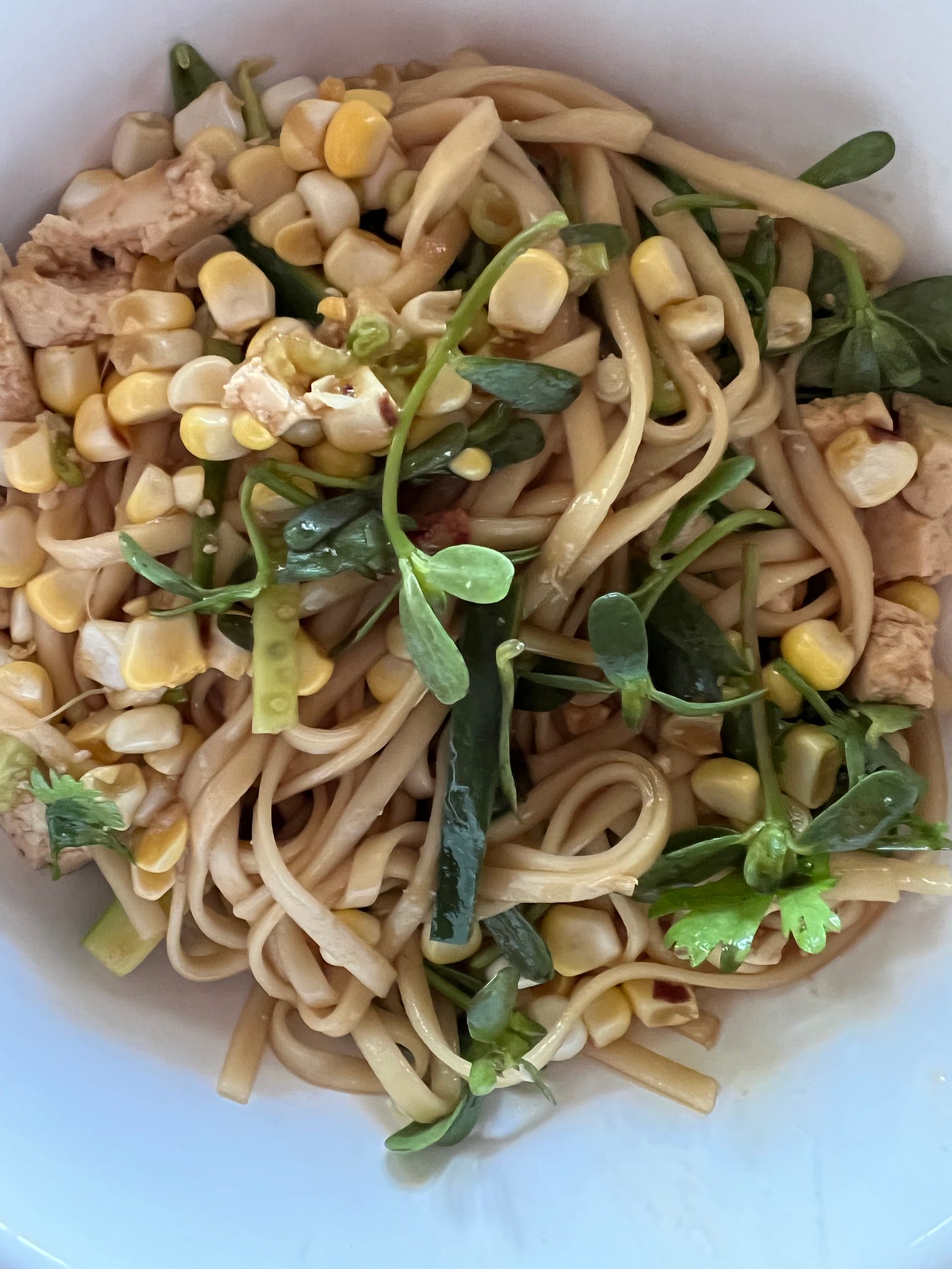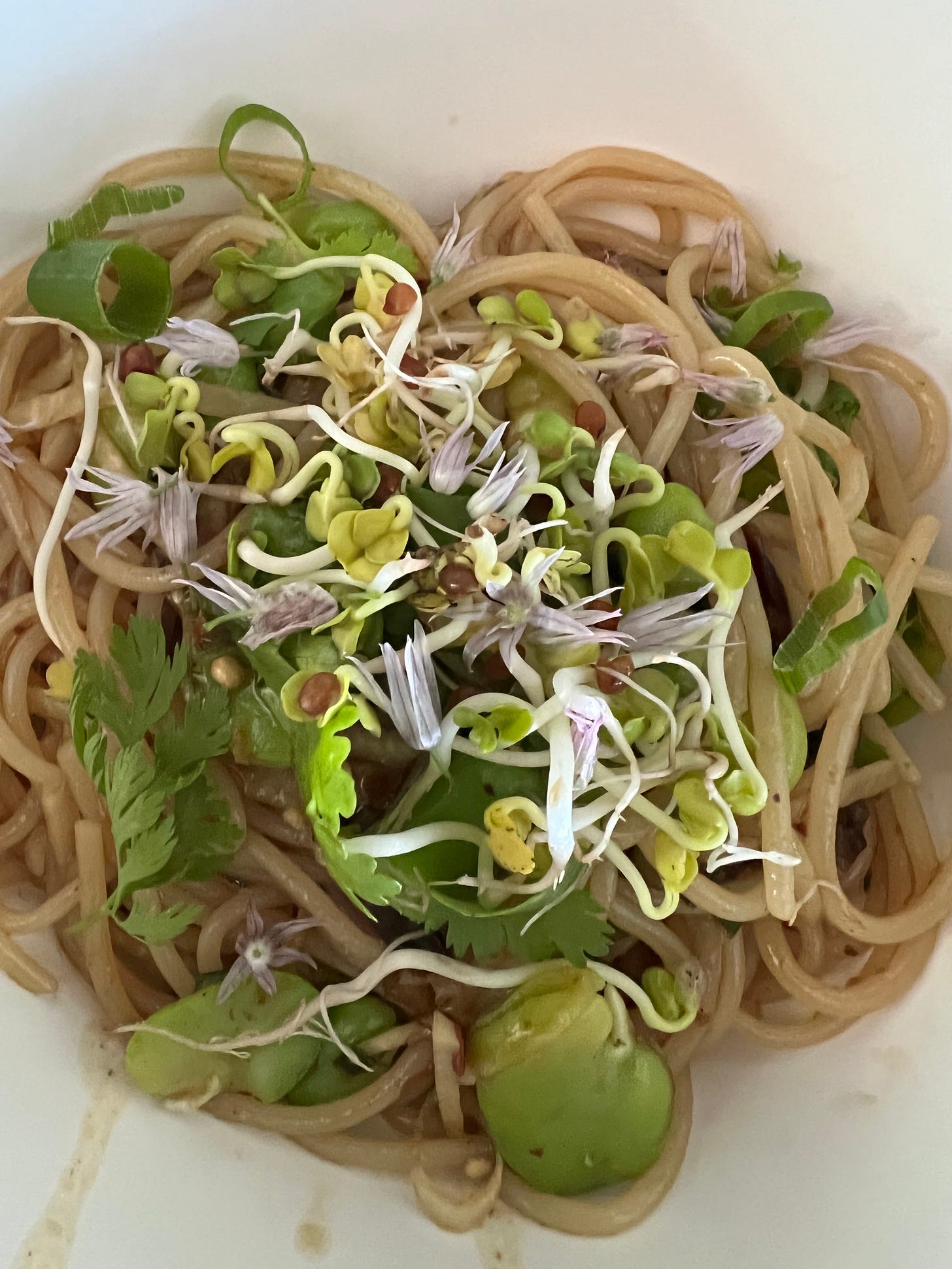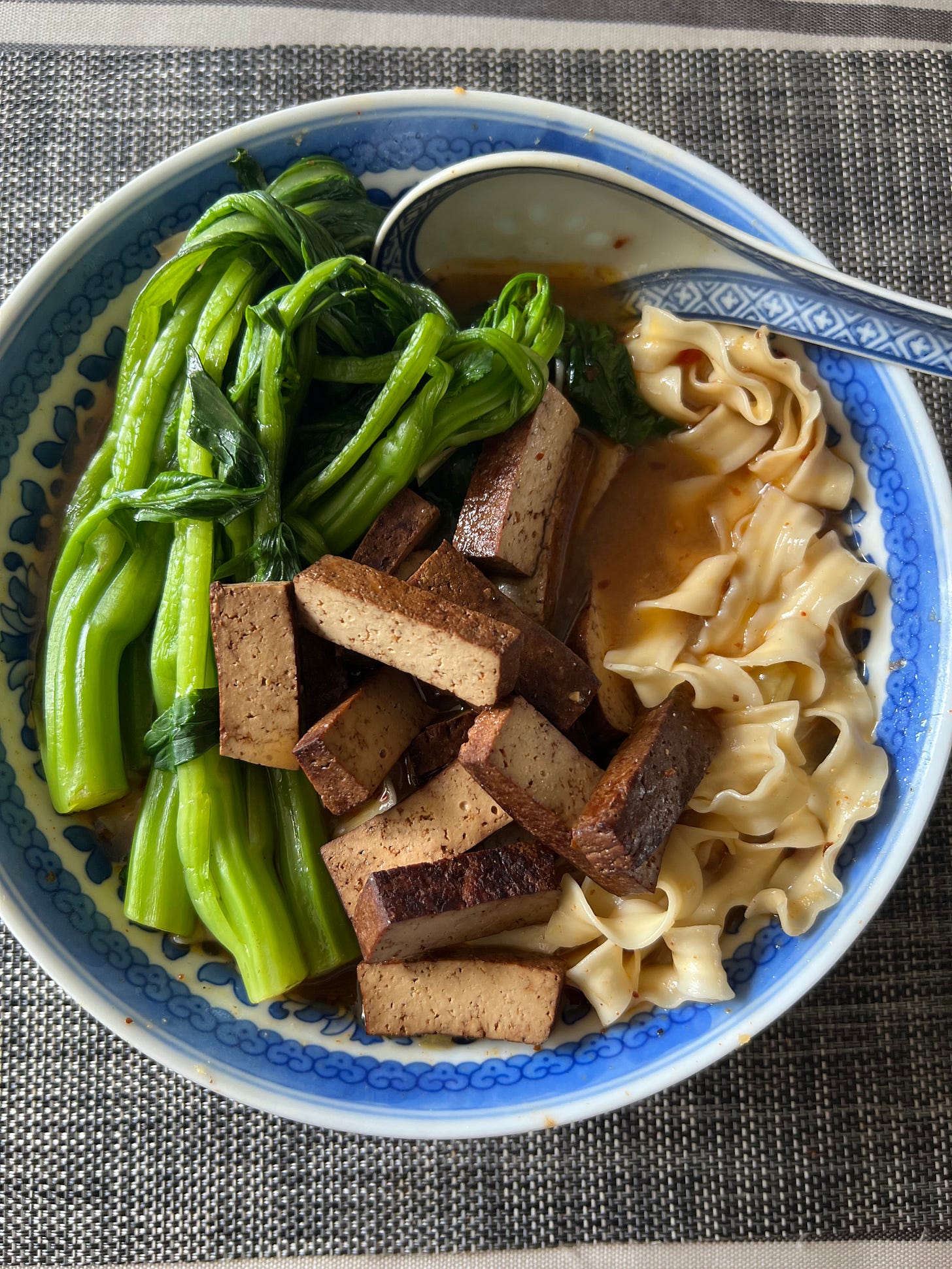Issue #72: Mitchell’s Noodle Shop is Open for Lunch
Recipes for Two Quick Chinese Noodle Dishes, One Cold, One Warm, Both with Unlimited Variations
The U.S. mid-term elections are less than four weeks away. Please make sure you are registered to vote wherever you live and then please make sure to vote. The future of our country, of our democracy depends on it. In the meantime, why not cook something? —Mitchell
Lunch when Nate and I are both working from home on weekdays in the city or at the lakehouse is often a bowl of Chinese noodles. I love noodles of every kind, whether Italian pasta, Jewish lokshen, Vietnamese bun, or Chinese mein. I like my noodles hot or cold, dry or soupy, boldy spicy or subtly sweet. (Nate prefers his cold, dry, and mildly spicy.) One of many fond memories of the trip we took to China to celebrate my 50th birthday—along with some of my dear friends from high school, who were also celebrating their 50th birthdays—was the noodle bar at the breakfast buffet in our swank resort outside Chengdu. Sichuan noodles for breakfast, what a great idea.

I considered it a triumph the other day when I got a text from Nate, who was up at the lake with Milo, that the kitchen seemed to be broken because it wasn’t making Chinese noodles any more. The reason for that triumphant feeling is because when I first met Nate some 15 years ago he really didn’t like Chinese food at all. Turns out, he’d never had any good Chinese food. And there really is little beside nostalgia to recommend the sweet, gloppy food served in bad American Chinese restaurants—even if it comes with a free glass of white wine while you wait for your table and all the fried noodles and fortune cookies you can eat. These days Nate craves the bold, mala and umami flavors of Sichuan food, the richness of Shanghai soup dumplings, the fragrant saltiness of roast duck.
Anyway, I make two styles of quick, go-to noodles for lunch, both ready in the time it takes to boil a large pot of water at the lakehouse (where, granted, I am working with a propane stove, so it takes longer for water to boil than it does eleswhere). The first has a light, tangy, soy-based dressing I usually serve cold. The second is a richer, sesame-paste-enriched, dan-dan-style sauce I usually serve warm. Both of them can be adapted for whatever you’ve got on hand.
Problematic as the term and the concept may be, I can’t say that the noodles I make are an authentic recreation of anything, really. As I’ve noted in previous newsletters, I have a few sources for Chinese recipes that I use as starting points. Woks of Life, Woon Heng, Serious Eats, Mala Market, and all of Fuschia Dunlop’s books are where most of my Chinese cooking journeys begin. Over time, I experiment and adapt. Rarely are two batches ever the same, dependent as they are, on what vegetables, condiments, and garnishes I have on hand. But they are always delicious. Just ask Nate.
A Word About Noodles
Although there are distinct differences between different types of Chinese noodles and between Chinese noodles and other Asian noodles, I’m not a stickler for using one over another for a quick bowl for lunch. I have a selection of dried Chinese noodles in my cupboard, mostly wheat based, a few made from rice or bean. I pick new ones up whenever I see them. This summer I brought back two types of noodles I hadn’t seen before from London’s Chinatown. Of the wheat, some are thick and alkaline, others are thin and flat. I’ve used Italian spaghetti in a pinch, though the texture is not quite right. Thick rice noodles, soaked and blanched, work well, too. I have made many a fresh noodle in my day, even the tricky, spongy alkaline noodles that are typical of ramen and recommended for cold Chinese noodle preparations. Freshly made noodles are good and can be frozen for easy use, but the price and convenience of dried noodles can’t be beat. I read the labels and look for those without any additives. Seriouseats.com has a good guide to different Asian noodles here.
A Word About Other Ingredients
These recipes are delicious as written, but I use them as guidelines that I adapt based on what’s in the fridge. If I have scallion oil or chili sauce or even leftover dumpling dipping sauce, I’ll throw some in. I made a large batch of fresh ginger purée last week for a few Indian dishes I was cooking, and I’ve been adding some of that into my noodles. You get the picture.
Because these recipes are so simple, I like to use the best ingredients I can find, usually higher quality soy sauces and vinegars than the most common, cheapest brands you find Chinatown shops. Read the labels to avoid unnecessary preservatives and other chemicals, such as potassium sorbate or MSG. The Mala Market is a great online source. The Asian market on the second floor of Jean-Georges Vongerichten’s new Tin Building has an impressive and impressively priced selection. But even any good Asian grocer will have different qualities of ingredients. Price is a good indication of quality, but read the labels, anyway. I know that there are subtle differences between Korean, Thai, Japanese, and Chinese soy sauces, for example, but I don't discriminate.

Because this is a meal-in-a-bowl situation, I like to dress my noodles with a generous amount of vegetables and some form of protein, often fried tofu, sometimes cooked beans, and occasionally thinly sliced leftover pork or other cooked meat. It all depends on what I’ve got. A handful of cilantro and/or a sprinkling of chopped, roasted peanuts makes for a pretty and tasty garnish. See more suggestions below. And have at it.
Vegetables
Cucumber, julienned
Carrot, julienned
Mung bean sprouts, blanched
Radish or other sprouts
White or green cabbage, finely shredded
Purslane
Fresh corn kernels
Cooked long beans or green beans
Asparagus, blanched and sliced
Gai lan, bok choy, or other Chinese greens, cooked
Pickled mustard greens
Fresh or reconstituted shiitake mushrooms, thinly sliced and quickly sautéed
Proteins
Fresh Tofu, fried in small squares
Spiced, pressed tofu, thinly sliced
Beans, any kind, cooked
Pork, beef, duck, or other cooked meat, thinly sliced
Garnishes
Scallions, by the handful
Chinese, garlic, or flowering chives, sautéed
Fresh Cilantro
Chive blossoms
Fried onions or shallots
Roasted peanuts, finely chopped

RECIPE: Spicy and Tangy Chilled Noodles
A sort of noodle salad that’s refreshing on a hot day. Adapted from thewoksoflife.com
(Serves 4)
10 to 12 ounces dried wheat noodles, or soaked rice noodles
4 tablespoons light soy sauce
4 tablespoons rice vinegar
1 tablespoon sugar
1 tablespoon chili oil, with sludge
1 clove garlic, grated to a paste on a Microplane
1 teaspoon toasted sesame oil
1 teaspoon dark soy sauce
½ teaspoon roasted Sichuan peppercorns, ground
½ teaspoon Sichuan peppercorn oil (optional)
¼ teaspoon salt
Garnishes
See list above for additional garnishes and make your own combination
4 or 5 scallions, finely sliced
1 cucumber, cut into julienne
1 carrot, cut into julienne
Cooked beans
Fresh cilantro leaves
Bring a large pot of water to a boil. Add the noodles, stir to prevent sticking, and boil 3 to 5 minutes, depending on the noodles, until tender. They should be a little past al dente, in the Italian idiom.
Meanwhile, in a large bowl, whisk together the light soy sauce, vinegar, sugar, chili oil, garlic, sesame oil, dark soy sauce, ground Sichuan pepper, Sichuan pepper oil, if using, and salt.
When the noodles are almost done, whisk about ¼ cup of their cooking water into the sauce. Drain the noodles and rinse under cold water for a minute or so to remove any excess starch and to cool down the noodles. Add the noodles to the bowl with the sauce and toss to coat. Add the garnishes and toss again. Let sit a few minutes so the noodles absorb some of the dressing. Serve in small bowls.

RECIPE: Mitchell’s Sesame Dan Dan Noodles
Cozy and warm on a cold day. Adapted from a Fuchsia Dunlop recipe that would be almost unrecognizable.
(Serves 4)
10 to 12 ounces dried wheat noodles
2 tablespoons toasted sesame paste
2 tablespoons light soy sauce
1 tablespoon dark soy sauce
1 tablespoon chili oil with sludge
1 tablespon xiaoxing cooking wine
2 teaspoons black vinegar
1 teaspoon toasted, ground Sichuan peppercorn
½ teaspoon toasted sesame oil
¼ teaspoon salt
Drizzle Sichuan peppercorn oil (optional)
Garnishes
See list above for additional garnishes and make your own combination
4 or 5 scallions, finely sliced
1 cucumber, cut into julienne
Cubes of fried tofu
Cooked gai lan or other greens
Fresh cilantro leaves
Chopped, roasted peanuts
Bring a large pot of water to a boil. Add the noodles, stir to prevent sticking, and boil 3 to 5 minutes, depending on the noodles, until tender. They should be a little past al dente, in the Italian idiom.
Meanwhile, in a large bowl, whisk together the sesame paste, light and dark soy sauces, chili oil, cooking wine, vinegar, Sichuan peppercorns, sesame oil, salt, and Sichuan peppercorn oil, if using. Beat 2 or 3 tablespoons of the hot noodle cooking water. Whisk until the sesame paste has broken up and the sauce is smooth.
When done, drain the noodles but do not rinse. Add warm into the bowl with the sauce along with your chosen garnishes and toss well before serving.



